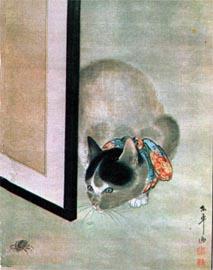CAT HISTORY
Felines through the ages
No one really knows how and when the domestic cat first appeared on earth, although there are many theories. However, there is reason to believe that cats were domesticated by man about 5,000 years ago. The first written reference to cats occurred in Egypt where the cat goddess-, Bastet (or Pasht), was worshiped. Bastet was seen as a human figure on a totem pole with the head of a cat.
Cat worship by the Egyptians went on for centuries, and cat figurines adorned with jewelry and other finery have been found in Egypt's tombs.

In fact, cats were so revered that the penalty was heavy for Egyptians who were caught killing them. When a cat died, it wasn't unusual for human members of a household to cut off their eyebrows to show their grief.
Cats, like many human beings of that time, were mummified. And even more amazing, archeologists have found mummified mice buried along with the cats to provide food in the afterlife. In those days a human funeral cost the equivalent of $1,500; a cat funeral amounted to about $500!
Cats also were worshiped in other countries. In China during the Hsia, Shang, and Chou dynasties (from 2205 to 225 B.C.), sacrificial rites and theatrical ceremonies were held in their honor and, like the Egyptians, a stiff penalty was imposed for their destruction.
Since the beginning of time, cats have played a significant role in the history of man. Cat clans in the Teutonic and Celtic countries proudly used the animals as emblems for their banners. Roman soldiers displayed cat figures on their shields, as did soldiers of other nationalities, including the Norsemen, forerunners of the Scandinavian people. The Norse goddess Freya is often shown in a chariot drawn by two cats. Norse maidens were married on Freya's day (Friday) if at all possible. If the sun shone during the ceremony, it was said that the maiden had taken good care of the cat and fed it well.
Cats spread throughout the world when soldiers and sailors adopted them as mascots to serve as rat-killers aboard ship. How important they were to the seagoing world is shown by such terms as catwalk, meaning a high, narrow passageway; cat-head, where the ship's anchor was hoisted; and cat-o'-nine-tails, a whip with which sailors were flogged.
From "Cats and Kittens" by Jane Rockwell